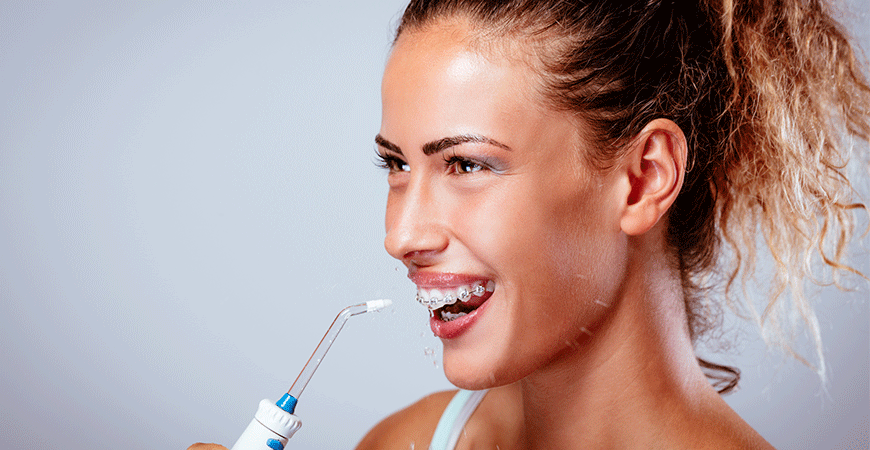A healthy smile is more than a beauty goal. It’s the sign of good dental hygiene that can also prevent cavities and gum disease. And, at the heart of a healthy mouth is a regular tooth flossing routine.
Brushing your teeth doesn’t always clean out those tight gaps and hard to reach places food debris can hide. But with regular flossing, you can whip away all that plaque and bacteria, above and below the gum line.
For the best results, you have a choice of two methods – the traditional floss and the newer, water-powered waterpik. Both are designed to deep clean your mouth and each method has its pros and cons. But which one comes out on top in the teeth cleaning stakes? We put both to the test to discover waterpik vs floss; which one is best?
What Is a Waterpik?
Also known as a water floss or oral irrigator, a waterpik is a nifty handheld device that uses pressurized water in a fine jet to dislodge tartar, plaque, and food debris from between the teeth. And waterpiks are growing in popularity, and are along with teeth whitening strips, are one of the most popular at-home ways to maintain a Hollywood smile.
For control, it also includes water temperature and pressure settings so you can tailor the jet to your mouth and the sensitivity of your teeth and gums. The pulsating stream of water found in the best water flossers can also be used to clean just beneath the gum line and rinse out your mouth.
When it comes to how to use a waterpik, you will need to practice a little to get the technique but once mastered, they are easy to use. And if you are already a dab hand at using an electric toothbrush, you should have no problem becoming a water flosser! They do need a water supply as well as power, so can be a little bulky, but you can get cordless devices which also have smaller water reservoirs, so are ideal for traveling.
A top tip when using a waterpik is to place the tip in your mouth before you turn it on, so you keep the water spray where you need it. With a choice of ergonomic designs, waterpiks are also a good choice if hand mobility is an issue. They are also particularly effective if you have had orthodontic work, such as braces, crowns, non-removable bridgework, or dental implants as it enables you to cleanly get into the smaller, tight spaces.

Waterpiks: Pros and Cons
Waterpiks certainly look smart and have a nice gadget vibe that’s also fun to use as well as a good way to fine-tune your teeth-cleaning routine. But are they the best way to floss your teeth? We weigh up the pros and cons of a water flosser.
Pros
- Water flossers are easy to use, once you get the hang of them, and don’t require the fiddly maneuvering you need with traditional floss
- They are also a good option if you have orthodontics, such as braces and bridges, as you can get into the tight spaces without interfering or catching on edges or wirework
- A waterpik be more comfortable to hold and use if you have arthritis or other hand mobility issues
- As well as flossing, a waterpik can also be used to rinse out your mouth for a lovely clean feel
- You also get adjustable speed and temperature settings so kind on teeth and gums
- Many water flossers will also create a massage effect to stimulate blood flow to gums.
Cons
- Compared to the ‘cheap and cheerful’ roll of dental floss or tape, the waterpik is an investment, typically costing between $30-$70, although some of the advanced models can cost $100 or more
- A water flosser is sizeable, as it comprises of a hand unit, the jet probe and water reservoir, as well as a stand or charger. This means you need enough counterspace in your bathroom to store it
- They also need access to power and water – so not so travel friendly as traditional floss
- While a good way to floss your teeth, the water jet may not be enough to remove all plaque in one session, compared to the more intense dental floss.
Flossing: Pros and Cons
So, is waterpik better than floss? Well, a water flosser is a good, safe alternative to flossing your teeth the ‘old school’ way. But dental floss or tape – which is typically made from thin nylon or Teflon string – is not ready to stand aside yet, when it comes to effective deep cleaning.
There is a technique to master with traditional flossing, but it does give you more ‘up close and personal’ control when cleaning in-between your teeth and is a proven way to keep on top of your dental hygiene. Let’s look at the advantages and disadvantages of traditional dental floss:
Pros
- Cost effective – traditional dental floss is significantly cheaper than a waterpik – a couple of dollars, or less.
- Convenient – with its compact size, dental floss is easy to use when traveling as well as at home
- With the right technique, dental floss gives you direct control over pressure and direction for a deeper clean
- Traditional dental floss also enables you to deep clean each tooth completely, effectively removing bacteria, plaque, food particles and plaque from between teeth
Cons
- While cheaper than a water flosser, dental floss is not re-usable and can be a challenge to dispose of as it is not recyclable
- Can cause your gums to bleed during or after use
- Dental floss or tape can be potentially damaging to gums if used incorrectly, or too much pressure is applied
- Can be a little tricky to use if you don’t have sufficient mobility or hand dexterity

The Bottom Line
Traditional dental floss is widely considered the most effective way to floss your teeth, although the waterpik is a good alternative. However, the water flosser may not give such a deep clean as floss, although it is an effective option if you have orthodontics or struggle with mobility in your hands. And, as with everything, it is a matter of personal choice whether you opt for a traditional floss or a water flosser – it is the method you will use regularly and consistently that counts.
What all dental experts agree on is that you should always floss your teeth at least once a day, in addition to your usual twice a day teeth-brushing.
FAQ:
Is flossing really necessary?
To maintain your oral health and prevent gum disease, cavities, and potential tooth loss, yes flossing is necessary. Without regular flossing, the bacteria in trapped food debris will calcify into tartar, which is one of the leading causes of gum problems.
Can water flosser replace flossing?
While water flossing works well to clean between your teeth, many experts suggest using a waterpik alongside traditional flossing. A waterpik cannot provide the scraping motion of dental floss, which is the most effective way to clean out those tight spaces between your teeth. The ideal solution is to combine a waterpik with a dental floss for optimum oral health.
Should I water floss before or after brushing?
The jury is out on this one, with supporters for both the before and after routine. Flossing before brushing can dislodge some of the plaque, to be brushed away afterwards. Alternatively brushing first can remove the bulk of the plaque, before your dental or water floss does the final deep clean. So, we say whichever way works for you, your teeth and maintaining that healthy smile is the best way!
The post Waterpik vs. Flossing: Which Is Best appeared first on BeautyBets.

